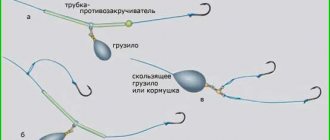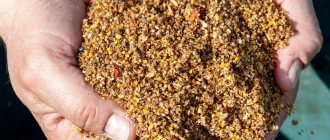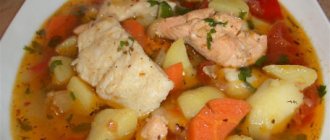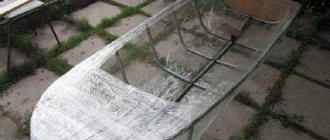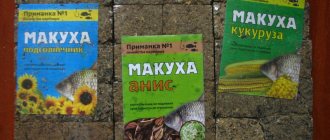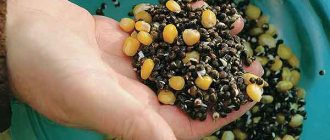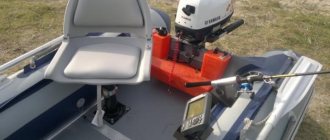Mastyrka
– one of the few baits that firmly and reliably stays on the hook.
Both river and lake fish bite excellently on this type of bait: crucian carp, carp, bream, silver bream, roach, ide, etc.
There are a great many recipes for making mastyrka It’s enough to change the proportions of the cereals, add something “from yourself” and that’s it - the author’s mastyrka is ready! You can, of course, buy ready-made... But the process of “shamanism” in the kitchen is so creative that having tried it once (and confirmed with a good catch), you will only go for store-bought as a last resort.
general information
Mastyrka
Mastyrka is a nozzle of plant origin, which is prepared on the basis of semolina flour, peas or potatoes. Various additives are often used in cooking - honey, sugar, oils, food coloring, etc. It is used quite often, since such bait is almost the best for any type of peaceful fish.
It is best to use mastyrka in the summer - the fish are most active, which means they will be attracted to any bait. In the case of summer fishing, you can use food coloring to attract fish with an unusual color. Winter fishing requires special recipes, because the fish will not react to a ball of peas - the nutritional value must be increased. The latter is done through various additives. Vitamins can also be used as one of them.
Methods for cooking crucian carp in the microwave
Nowadays, there is a microwave in almost every home, but it is most often used for other purposes. Few people know that in fact a microwave, that is, an oven that works thanks to special wave radiation, is not intended for simply heating food, but for preparing it. Moreover, this is not an additional, but the main purpose of a microwave, because using it to heat food, unfortunately, has a rather bad effect on the true quality of the food. At the same time, dishes prepared according to recipes in a microwave oven turn out very tasty and delicious. Moreover, most microwave ovens are equipped with a grill function.
Modern microwave oven
Recipes for a variety of dishes with photos can be found on the Internet, but most often a special recipe book is sold along with the microwave oven, which is also accompanied by various “appetizing” photos and will become a real kitchen assistant for any housewife.
Mastyrka recipes
This bait is not very difficult to prepare and is especially popular among fishermen due to its high performance.
Components:
- Pea flour - one part;
- Semolina - one part;
- Water – two parts;
- Yellow or orange food coloring - on the tip of the knife;
- Sunflower oil (not refined) – teaspoon;
- Small saucepan with lid;
- A large saucepan that holds a small one.
Procedure for preparing mastyrka:
Let's start by preparing pea flour. We will need an ordinary coffee grinder and dry peas. Everything is very simple: add peas; ground; sift the prepared flour through a sieve into a separate bowl; We throw what is not ground back into the coffee grinder and repeat the procedure. Pour pea flour and semolina in equal proportions into a small saucepan. Add yellow or orange food coloring to the tip of the knife. Dye is a component that you can do without, but its presence is very desirable. You need to pour exactly as much water into the saucepan as semolina and flour take together. Mix this mixture thoroughly until smooth. Fill half a large saucepan with water and place on the stove. Place a small saucepan, covered with a lid, in the middle of a large saucepan. We got a water bath. In this way, we will protect our bridge from burning on an open fire. Bring this to a boil and from that moment cook for 20 - 25 minutes. If water boils in a large saucepan, add boiling water from the kettle. We take the resulting porridge out of a small bowl and begin to knead it like plasticine.
Initially, mastyrka may be a little rare, but don’t let that bother you. Knead it like plasticine until it hardens while it is still hot. Has it thickened? We take unrefined sunflower oil and mix it into the mastyrka. At this stage, you can add aromatic drops to the mastyrka, for example, anise or some of the newfangled products.
Mastyrka for crucian carp
Crucian carp is very picky in choosing food. So, this matter should be approached with special diligence. There are several recipes for preparing mastyrka, which work great when fishing for crucian carp:
- Recipe No. 1 - first, take care of the peas and place them in water for twelve hours. Next, the soaked peas are twisted in a meat grinder several times. Semolina is added to the prepared mass until the required consistency is obtained. If the potential mastyrka dough turns out to be too hard, you need to add pea broth to it. If it turns out that the mastyrka is too liquid, add wheat or semolina to it. It is worth noting that such a mass will stick perfectly to the hook and have a pleasant smell, which will allow the fisherman to have a better chance of a successful catch.
- Recipe No. 2 is another effective recipe for making mastyrka for crucian carp. However, you should not think that these recipes serve as an excellent bait only for catching crucian carp, since this mixture can also be used for bream and even carp. To prepare this version of mastyrka, you need to take a loaf of bread. Note that the bread must be coarsely ground, rye. Also needed: several potatoes, corn flour, sunflower/corn oil. In this case, mastyrka is cooked in the same way as in the previous recipe, only with the addition of the above ingredients as it boils.
Mastyrka for bream
Vegetable baits are very effective when fishing for bream. In this regard, it is advisable to resort to a special recipe for preparing mastyrka for bream. The list of ingredients for preparing mastyrka for bream includes the following components: semolina, peas (regular), a teaspoon of honey.
In order to prepare high-quality mastyrka for bream, you need to fill the peas with cold water in the evening and leave it in this state until the morning. After this, a pan of water is placed on the fire, and peas are poured into it. Thus, the peas should be cooked for about two hours. After two hours, remove the peas from the heat and drain the water through a sieve. Using a sieve, you need to pass the peas in such a way that only the porridge without the shell remains. To improve the taste of mastyrka, add a teaspoon of honey. It is worth saying that bream is an admirer of honey baits. Next, add semolina to the resulting mixture until you have an elastic dough.
Mastyrka for carp
Carp by nature is a true gourmet. Therefore, when fishing for carp, fishermen often use a combined mastyrka, which contains several ingredients: potatoes, millet, makukha, rolled oats, processed cheese, corn grits, etc.
To prepare such mastyrka, the fisherman will need potatoes boiled in their jackets. It should be peeled and then cooked until tender. Once the potatoes are ready, drain the water and start mashing the potatoes until they are pureed. Next, the potatoes are mixed with grated, cooked peas in a ratio of 6:4 (peas: potatoes). Next, semolina is added to the mixture. The resulting mixture is cooked in the standard way. If the future mastyrka is not viscous, add a little flour to it.
The famous mastyrka from Mikhalych
The bait according to the recipe of the well-known video blogger Mikhalych is considered among fishermen to be the most catchy and versatile. It can be hung on a hook or used in feeders.
You will need: 7 glasses of water, 3 glasses of split peas, 2 glasses of semolina, 1/5 tsp. cinnamon, 2-3 tbsp. l. granulated sugar.
What to do with all this:
- pour water into a saucepan, let it boil,
- add peas, cook with regular stirring until tender,
- add sugar,
- mix a glass of semolina with cinnamon, gradually pour into the pea porridge,
- remove the pan from the stove and use a masher to thoroughly mash the mixture until smooth,
- add a second glass of semolina in small portions, continuing to work with the masher.
When the mixture begins to resemble a thick dough, leave the pan with the mastyr to cool. During this time, the semolina will swell even more. All you have to do is knead the elastic mass with your hands and roll it into balls or sausages, depending on your fishing needs.
You can familiarize yourself with the step-by-step preparation of mastyrka from Mikhalych by watching this video:
Fishing with mastyrka
You can fish with mastyrka in almost any layer of water. They are caught using bait and bottom and float gear. A well-prepared mastyrka can withstand up to three long-distance casts. You can add mastyrka balls to the bait, as you do with boilies. You just need to show moderation in this matter.
Methods of planting mastyrka
- Mastyrka on a hook, method 1
- Mastyrka on a hook, method 2
You can plant the mastyrka in different ways. The methods differ depending on who exactly you are catching:
- When the bite subsides a little, you can form a small maggot out of the bait and put it on a small hook. It performs quite well when catching bluegill, bleak and even small crucian carp.
- Most often, balls are made from mastyrka - it needs to be hooked deep enough. It is universal, and therefore there are no special tips or recommendations.
- For small fish, the ball needs to be placed deeper, on the very fore-end. This way you can catch enough rudd or bream.
- An oblong drop - the hook goes deep enough. Quite versatile, and therefore can be used whenever you want.
- A half-drop, brought to the level of the sting, shows itself perfectly when catching roach.
How to store finished mastyrka
The advantage of this bait is that it can be prepared for future use and used as needed. The only condition that must be met is to store it correctly. The fact is that open air has a detrimental effect on mastyrka - it can very quickly dry out, become acidic and lose its attractive smell. Therefore, it is stored in a cool place, for which it is better to use a thermal bag. If you have prepared a softer mask for springs, put it in the bait bucket and close the lid.
The most common storage methods include:
- Freezing the prepared mixture - for this purpose, it is divided into portions, each of them is placed in a plastic bag and cooled in the refrigerator. The volume of a piece of mastyrka should correspond to the need for bait for exactly one fishing trip. If it is larger, the remainder will have to be thrown away.
- Freezing the bait base - for this purpose, the peas are first boiled, then crushed to make a puree, poured into plastic glasses and cooled in the refrigerator. Mastyrka is prepared immediately before fishing. Wheat flour or semolina, as well as flavorings, are added to the pea puree.
- Drying the dough, rolled out in layers, laid out on parchment paper in a flat dish, in the oven or microwave. Then the dried leaves are ground into powder and stored in a hermetically sealed glass container. The dry mass is dissolved in water at the fishing spot and aromatized, because during storage the original smell of the bait disappears.
- Forming boilies - for this, “sausages” are created from the finished mixture, cut and rolled into balls, which are boiled in boiled water until they float. Then they are laid out on the canvas to dry. For this purpose, you can use a microwave or oven. Dry balls are placed in bags and frozen.
You can freeze mastyrka by wrapping each piece in calico fabric measuring 25x25 cm and placing it in a plastic bag that can be hermetically sealed. Before fishing, take one portion out of the freezer and place it in the lower section of the refrigerator. After 5-6 hours the mastyrka will thaw. Then it is removed from the refrigerator and transported to the fishing site. Upon arrival, it will already be at ambient temperature. It is unrolled and rolled into small balls or cut into cubes measuring 5x5 mm and placed on hooks.
It will be useful for you to learn how to gut and fillet bream.
Mastyrka storage
Each portion is wrapped in a clean cotton piece of cloth and packaged in a dry bag or cling film. It is better to place all the “balls” in one container that is not afraid of freezing or in an ordinary dry plastic bag and in the freezer. Before fishing, we take out a portion in advance and leave it on a shelf in the refrigerator for even defrosting.
Such mastyrka can be stored for a long time, for months. You will save yourself from going to buy store-bought mastyrka, which often turns sour before you get the gear!
How to cook corn mastyrka
This bait is characterized by bright color, good smell and taste, sits perfectly on the hook and does not fall off when casting. It is perfect for catching bream.
- The main advantages of the recipe below include:
- high density of mastyrka, thanks to which it is used as a nozzle and spring bait;
- After cooking, you won’t have to clean dirty pots with burnt bottoms;
- The versatility of the nozzle: it is suitable for both long-distance casting and fishing with a float.
We recommend reading about the features of fishing for carp.
Ready-made corn mash is used:
- placing it on both the hook and the hair;
- as bait using a spring;
- filling the feeder when fishing with feeder gear;
- in the form of molded balls that are thrown as bait.
To prepare the bait you will need corn and wheat flour in a ratio of 3:1, flavorings, two plastic bags, and a container of water.
The cooking instructions are as follows:
- Corn and wheat flour are lightly fried in a frying pan. This technique allows you to get mastyrka with a pleasant taste. Wheat flour will increase the stickiness of the bait.
- Then add water little by little to the mixture and mix, bringing the mass to the consistency of thick sour cream. You can sweeten the mastyrka with honey, sugar, strawberry or raspberry extract, change the smell with vanilla, coffee beans to make the attachment more attractive.
- Fill a plastic bag with the finished mixture and tie it. Additionally, they are placed in another bag.
- Place the bags with the mixture in a bowl and fill it with water to cover the contents. Then put on fire and cook for half an hour. If the consistency of the mastyrka should be denser, the cooking time should be increased by 10 minutes.
- The cooked mastyrka is infused for 5-6 hours.
Adding grated cake or seeds to the bait can worsen its stickiness and color. The best option would be to do this at the fishing spot when forming the bait on a spring. You can mix the bait with grated seeds or cover a ball of dough with dry bait, parts of which will separate from the bait in the water to attract bream.
The bait is not removed from the bags, but taken to the fishing spot so that the porridge does not turn sour. There the bait is cut into square pieces or rolled into small balls. The most commonly used bait additive is sunflower oil. Approximately 1 tsp. it is poured in when preparing the dough or, when filling the spring, mixed with the finished mastyrka.
Important! With the approach of autumn cold, it is advisable to increase the attractiveness of mastyrka by adding flavorings that smell like shrimp, crab, caviar, and crayfish.
Mastyrka in the microwave for crucian carp
Mastyrka is a special bait for catching fish, including crucian carp, which is partial to this bait. Many fishermen use mastyrka prepared independently. There are several recipes and methods for preparing this bait, but the fastest way is to prepare mastyrka in the microwave.
To do this you will need:
After the main components are prepared, you can proceed directly to preparing the bait:
The process of preparing mastyrka
Thus, a microwave oven provides many opportunities not only for cooking crucian carp bought in a store, but also, in principle, can become an assistant in catching this delicious fish, which will always decorate the holiday table.
Source
Air dough for fishing
This type of bait is prepared on the basis of egg yolks . They need to be combined with the flour without adding water, and knead into a loose dough. The dough is then wrapped in a plastic bag and tied tightly. Place the bag in a pan of boiling water and boil for minutes. You can form balls from the cooked dough.
You can prepare the dough in advance and store it in the refrigerator. In this case, the temperature should be about +6-11, and it is prohibited to store dough for profit in the freezer.
All the fishing dough recipes listed in this article are just the tip of the iceberg. There are a huge number of recipes . Almost all types of flour are suitable for preparing bait, so you can experiment on your own and come up with new mouth-watering delicacies for fish.
Installation of silicone baits. You will read about this in our article.
And here we talk about the equipment of a sliding float.
This section https://lovisam.net/vidy-lovli/trolling is all about trolling.
Mastyrka in 5 minutes in the microwave: detailed analysis
Additional components are considered:
One of the important components, without which catchy fishing is unthinkable, is bait. The bait is determined by the habits of the fish that are going to be caught. Crucian carp is a very common fish and a desirable catch for many fishermen. Its diet is very varied, so the choice of baits for crucian carp is quite significant. Among the baits of plant origin, mastyrka is very popular.
Pea is the most popular. Beginning fishermen, seeing how their experienced comrades successfully catch fish with a mastyrka, over time ask themselves questions - “What is it, what is caught with it and where to get it?”
Pea mastyrka for fishing in the microwave in 5 minutes. My fishing.
279,612 views
Quickly prepare pea mastyrka for fishing in the microwave in 5 minutes. My fishing.
The composition “Easy Jam” belongs to the performer Kevin MacLeod. License: Creative Commons Attribution (https://creativecommons.org/licenses/by/4.0/).
Original version: https://incompetech.com/music/royalty-free/index.html?isrc=USUAN1100245.
Almost every experienced fisherman knows what a mastyrka is.
Recipes for crucian carp in the microwave
Cooking crucian carp is a fairly simple task, since this particular fish is quite juicy and does not require long heat treatment for cooking.
There are many ways to cook crucian carp in the microwave; let’s look at the most common and simple recipes:
Crucian carp baked in the microwave in a sleeve. To bring this recipe to life you will need: a sleeve, sour cream or mayonnaise, seasonings (to taste).
Cooked crucian carp in the sleeve
After the necessary products and tools are prepared, you can start preparing baked fish:
If you want a more refined dish, you can prepare a white sauce with herbs by adding chopped herbs to mayonnaise or sour cream to suit your taste.
Crucian carp baked on the grill. In order for the crucian carp to be baked not using microwaves, but on the grill, your microwave must have such a function. To prepare, you will need the crucian carp itself, seasoning to taste and a grill function in your microwave.
After pre-cleaning the fish, you can start cooking:
There are many more interesting recipes. You can independently diversify your dishes to suit your taste or read thematic culinary forums. If you are the happy owner of a large and powerful microwave oven, then you can immediately cook the fish along with the side dish.
What fishing gear to choose
You need to choose gear for catching crucian carp depending on where you are going to fish. Thus, fishing on lakes with spacious water areas and large rivers is most effectively done with the help of a feeder, which you can use from early spring to late autumn. But it is worth remembering that during the spawning period, fishing with such gear will be unproductive, since at this time the fish quickly moves from place to place.
In overgrown reservoirs or ponds with many fallen trees, it is better to catch crucian carp with a float rod. The same equipment will be most suitable for fishing from a boat. You can take a fishing rod with a large rod for long casts. This gear is especially effective for fishing in early spring: hungry crucian carp during this period, in search of food, go close to the shore, where the water warms up faster and the ice melts. They hide near large stones, reeds and snags.
Bottom tackle is excellent for fishing in medium and large lakes, as well as in ponds and rivers with a powerful current. But before casting, study the bottom topography and make sure that the tackle does not get caught on algae, snags, or bushes, because this can lead to its breakage.
The easiest way to get dough for fishing
To prepare the dough, we need any kind of flour. We put it in a deep plate and add a little water at a time. Mix the mixture with a spoon, a stick, or your fingers. The dough can be made in different densities. If we fish in a body of water that is not still, we make it soft. If we fish on the current, then we will need something harder.
Roll out a ball of dough and test how it wrinkles. If the hardness suits us, then we finish cooking. If it turns out too soft, then add more flour and stir some more. If it is hard, then add flour. You can get a very soft dough, like semolina. In this case, it is better to use the following hooks with a spring:
On such hooks, semolina and soft dough hold well, and fish can be caught even in a small current using a donk and a feeder. Take note of this point. Perhaps it will come in handy in cases where the fish refuses to take other baits. It is better to wind the dough on such a hook.
Bait and bait supply
In general, if you make allowances for some of the features of this type of fishing, then everything is simple. Firstly, we remember the law: what we feed is what we catch. In our case, everything is exactly the opposite. What do we catch? That's what we try to feed. We cook peas for bait in almost the same way. just like we cooked it to make porridge for fishing, but slightly, so to speak, undercooked. This is done so that our bait still contains whole peas or their halves. Part of the porridge, therefore, when it gets into the water, will turn into a cloud of turbidity, and part will settle in the form of feeding grains. We do not add anything to the finished peas. except, perhaps, a small amount of the same semolina, for dregs.
When fishing, it doesn’t matter whether we fish with a float or a feeder, we throw our thin and slightly watery bait into the fishing spot like this. to create a rich and dense bait spot. We throw it without regret - after all, most of it is dregs, and the crucian carp will not eat it and will not get enough of it, it will only “work up” its appetite.
You can experiment with one very interesting addition to porridge - powdered milk for babies. The main thing is to choose something simple, without special additives, etc. We add the mixture to the porridge immediately before feeding, because it sours very quickly, especially in the heat.
Having tried this additive for the first time, I was sure that I would scare away all the fish, but within an hour the cage had become heavier by a good kilogram of good crucian carp, and the subsequent hours were generally remembered vaguely. I fished and fished and fished... After four hours of fishing I found an almost full cage in the water. I had to think about the catch rate and reel in my fishing rods. After this, if you plan to go crucian fishing, you always have powdered baby milk with you. It worked in different ways, sometimes better, sometimes worse. I will say one thing: I never scared the fish away, just the opposite.
